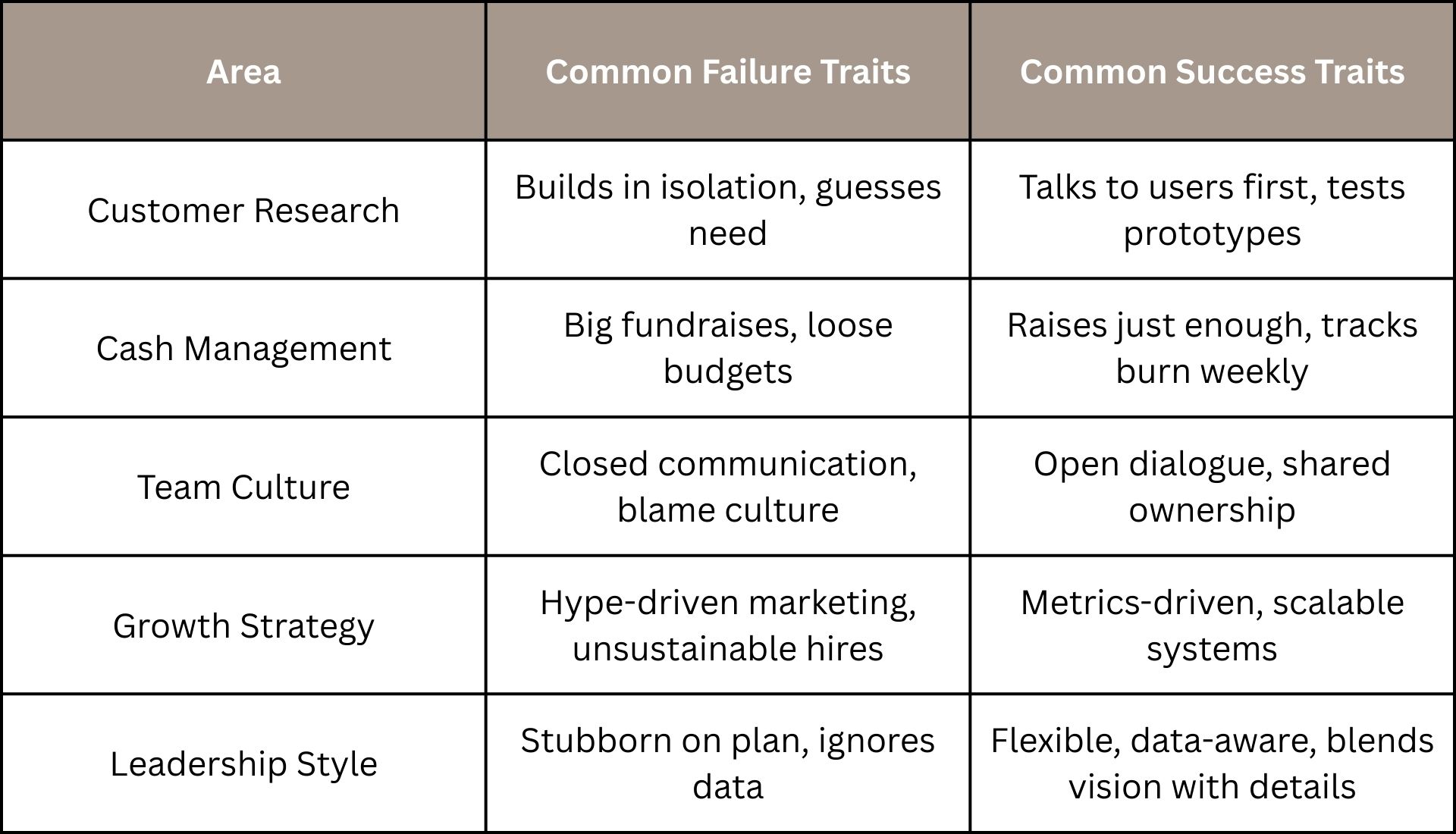Everyone has an idea, but not every idea becomes a success. Why do most startups fail while a few rise above the rest?
Starting a business is exciting. You feel excited, possibly have some money, and you want to make your dreams a reality. But often what happens is most startups fail and are not around after their first few years.
Some collapse under money pressure. Others develop products that people don’t really want. lose direction over time and are left confused about why things didn’t work out. In the end, they have no clue what happened.
What is it that sets those rare 10% apart from the rest? It’s important to notice common mistakes and find out which factors make some startups stand out.
Table of Contents
- The Stark Reality: How Many Startups Don’t Survive
- Common Pitfalls: What Trips Up the 90%
- The Winning Habits of the Top 10%
- Finding and Cementing Product–Market Fit
- Building a Resilient, Adaptive Team
- Growing Fast—Sustainably
- Founders Who Stay Hyper-Aware
- Real-World Case Studies
- Side-by-Side: Failure vs. Success Patterns
- Conclusion: Turning Insight into Action
1. The Stark Reality: How Many Startups Don’t Survive

Findings from CB Insights, the U.S. Small Business Administration, and industry analysts all agree on one message: Only one out of ten startups manages to succeed. Before they have time to set roots, most of them do not succeed, and this often happens within the first few years of operation.
Why so many? Starting a new business is made more difficult by the perfect storm. Working with a small budget, a small team, and the great uncertainty of not knowing the market. A great idea can be ruined simply by making a mistake in the execution or overlooking some key issue.
2. Common Pitfalls: What Trips Up the 90%

In companies that close their doors, you’ll often find the same core missteps playing out:
- No Genuine Problem-Solver. Not having a clear view of what customers want is like sailing without any direction. Juicero, a costly juice maker that was designed for special juicing packs, failed after many consumers found they could press the packs by hand to get the juice. The lesson: wait until you see people truly needing a solution before building.
- Cash Running Dry. It is common for a startup to go through money much faster than expected. Even though Pebble Technology collected $40 million from investors, startup fail still when they miscalculated how much it would cost to manufacture their product and how many people would buy it. A lack of clear predictions and plans can cause a company’s assets to disappear, even if they have a rich budget.
- Team Friction or Gaps. Issues within the team of co-founders or not enough key leadership (no marketer or operations lead) can prevent decisions from being taken. While the technology behind Theranos had weaknesses, the company’s failure was caused mainly by keeping information secret and discounting expert advice.
- Marketing Misfires. If your product is the best in the world, but no one knows, it won’t do you any good. The main reason many consumer apps do not work out is that they could not engage with their intended customers.
- Stubbornness Over Data. When new signups drop or users stop engaging, getting to the bottom of the problem and testing solutions should be your priority. Startups that stick to one plan, even when the market shows them different, usually end up startup fail.
Even if just one of these problems arises, the combination of all five can destroy a young business.
3. The Winning Habits of the Top 10%

So, how do the survivors act in a way that lets them survive? Coming up with an invention is rarely something that happens suddenly. The majority of them rely on daily, straightforward habits that form lasting results. Make an effort to talk to real people as early and as often as possible. The top founders take time to interact with users before writing a single piece of code.
- Talk to Real People Early and Often. I talk to people, observe when they are frustrated, and build very simple samples. In the beginning, Airbnb was started by Brian Chesky and Joe Gebbia, renting out just their living room at a design event. The original talks set the tone for how their business would be operated.
- Embrace Rapid Experimentation. Winners release a simple form of their product and use what people want to make improvements. The founders of Slack started using it as an intranet tool for their gaming company, Tiny Speck. Seeing that their teammates valued the game more than the prize,the company adapted and created Slack as a standalone product after realizing its team communication tool was more valuable than the game.
- Measure What Matters. While downloads may be vanity metrics, successful startups pay more attention to how people use the app, their timeline as users, and the costs and values involved. They understand that an improvement in weekly active users by 10% matters more than adding a new, but cosmetic, design.
- Maintain Cash Discipline. While they receive funding, top startups make sure to have strict budget plans and expect the worst situations. They secure enough funding for the following year or two, but not for a longer period of five years. This way of thinking requires them to show initial progress before getting any additional money.
- Build a Culture of Openness. Keeping in regular touch, supplying dashboards with clear stats, and providing friendly areas for honest feedback allows teams to spot small concerns ahead of bigger ones. Butterfield, the CEO of Slack, recommends not letting politeness keep people from giving helpful feedback
- Plan to Scale from Day One. Consider Scaling Your Business Even Before You Start. Quick growth is important, but creating systems that can support that growth matters, too. Planning your support, onboarding, and infrastructure for a 10× scale today will save you from trouble when your product becomes successful.
By practising these habits regularly instead of only focusing on them for a launch, startups develop qualities that help them in the long run.
4. Finding and Cementing Product–Market Fit

The essence of a successful startup is resolving a real issue that people want to buy and use. Only when there is product–market fit will an idea truly be a must-have service.
The Airbnb Example
In early 2008, Airbnb was struggling. There were more listing hosts than guests, and their funds were running low. Chesky and Gebbia went to New York with a basic strategy for their business. After meeting their hosts, took pictures of the places, and listened to what bothered them. They realized that most hosts did not enjoy taking poor photos and managing awkward paperwork. They then hired a photographer to re-shoot each property and introduced a single, easy-to-use option for payments. Bookings exploded.
Key takeaway: Guessing your product’s needs won’t help; instead, watch actual users use your product and address the issues they experience.
The “Build, Measure, Learn” Loop
Eric Ries’s Lean Startup approach illustrates this idea in a wonderful way. First, make the simplest version, observe how it’s actually used, see what needs improvement, and make the required improvements. Firms such as Dropbox created a basic video to establish there was demand for their product before writing any programs. Only 24 hours after the post, lots of people began signing up for the beta waitlist, indicating that the issue was real.
5. Building a Resilient, Adaptive Team

Successful startups rarely come about because of only one genius. Clear goals are important, as is the ability for a team to revise its plan if something goes wrong. This explains how the best teams manage to cooperate and be productive:
- Roles and Trust: All team members are responsible for different important duties. Engineers create, marketers speak with users, and ops ensure everything is up and running. The early hires are made more slowly and thoughtfully, making sure they are good fits for the team’s essential traits.
- Psychological Safety: Employees in safe environments, according to Amy Edmondson, tend to guide organisations toward faster innovation. From Google’s first Aristotle research, it was found that openness had the most significant effect on how well a team worked together.
- Rapid Realignment: If a sprint doesn’t go well and a new feature flops, the team meets quickly to see what caused it and quickly reassigns people where necessary. Instead of assigning blame, teams should focus on quickly identifying the root issue together.
- Celebrating Wins: Even little successes, such as a registration, good word of mouth, or a bug correction, can lift team spirits. Buffer made its performance data public—both successes and failures—fostering a culture of transparency and learning, supporting a learning culture.
When communication, trust, and clear ownership are prioritized, teams in startups are better able to handle struggles and come out more confident afterward.
6. Growing Fast—Sustainably

Let’s be honest: speed is non-negotiable. Things can change fast in markets, suddenly bringing up new competitors and reducing attention paid by users. Having reckless growth can also put a company at risk, just as much as not growing at all.
Smart Scaling in Practice
Take Zoom, the video-conference platform. From 2011 to 2014, Zoom experienced a steady rate of growth. Hiring engineers to ensure quick responses, spending well on growing server capacity, and making sure anyone joining the app could start a call with a single click. Thanks to its prepared infrastructure, Zoom was well-equipped for the pandemic in 2020. While the number of people using Zoom meetings increased from 10 million per day to 300 million per month, the service never crashed.
Meanwhile, in the same year, Quibi started as a service for short videos. While receiving $1.75 billion in funding, it found it tricky to get people on the platform, rejected suggested updates from users, and blew its budget on advertising rather than making the experience better for users. In the following six months, the company closed.
Lesson learned: Priorities the things that help users have a better experience and stick around, and not simply on grabbing attention.
7. Founders Who Stay Hyper-Aware

Most of the time, the success of a startup comes thanks to a founder who pays close attention and knows when to not interfere. They focus on both the broad goals and the routine tasks.
- Weekly Financial Pulse: Unlike reviewing forecasts just four times a year, they inspect cash flow, burn rate, and runway weekly, preventing any sudden shortage of funds.
- Regular User Interactions: Tesla’s Elon Musk is well-known for studying all customer emails sent to the company. Even though this isn’t something everyone is able to do, many founders often connect with their top users through calls to get honest feedback.
- Data Spotlight: On day one, they help you get basic charts up where you can watch things like how many people use the app each day, who is leaving it, and how many support messages are coming in. When cancellations rise by 5% or less, hotels look into the issue promptly.
- Market Radar: Members of the team make time weekly to visit industry news sites, keep an eye on the competition, and notice any changes coming up in regulations.
The combination of attention to detail and giving others tasks helps ensure that nothing significant is missed as the company grows large.
8. Real-World Case Studies

Let’s pull it all together with two contrasting stories—one success, one failure—so you can see these principles in action.
Airbnb: From Near-Death to Global Giant
- Problem: Getting guests and paying them became challenging for many hosts.
- Action: Leaders toured the countries, got to know each host face-to-face, reworked every listing, and put in secure payment options.
- Result: The number of bookings jumped, they secured a Series A based on solid numbers, and by 2024, the company had more than 150 million guests worldwide.
Key habits: Good businesses spend time talking to their customers, try out new ideas gradually, and grow their setup carefully.
Juicero: Shiny Gadget, No Real Need
- Problem: A juicer for sale for $400 that could be used only with their special juice packs.
- Action: Despite securing $120 million and running heavy marketing, the company never focused on the main issue: users preferred squeezing slurpees by hand for free.
- Result: Juicero’s sales fell apart, and the company was hit by negative media reports. As a result, Juicero stopped operations in 2017, just three years after it debuted.
Key missteps: not checking if there is real demand, spending resources on advertising, and not noticing what users do.
9. Side-by-Side: Failure vs. Success Patterns

Conclusion:
The reason 10% thrive and 90% startup fail has nothing to do with luck; it’s about the choice of habits and small details they don’t miss.
If you want to give your business the best chance to succeed, then focus on two key principles:
- Validate Early: Speak to users over a few weeks, not a long period, before starting to build your product.
- Iterate Rapidly: Get the basics ready, try things out, and then update them based on your success.
- Mind the Money: Always be mindful of your spending; look over what you spend every week.
- Build Culture: Take your time on new hires, welcome transparency, and celebrate every little success as a group.
- Scale with Care: Do what you can to automate, track important progress, and set up your systems for growth.
- Stay Alert: Focus on dashboards for key metrics, communicate often with influential users, and look for things changing in your market.
No startup journey is guaranteed. By studying what Airbnb, Zoom, and Slack did to succeed, you can improve your chances too. The road will be bumpy however There will be times when you hit dead ends and run into challenges. Yet, with these things in mind, you can adapt to any situation and even become part of the 10% who succeed.
